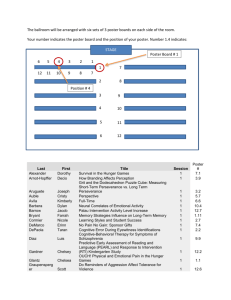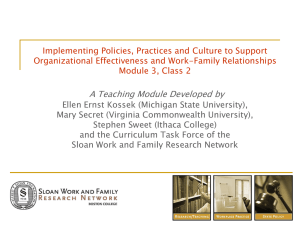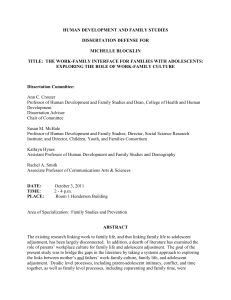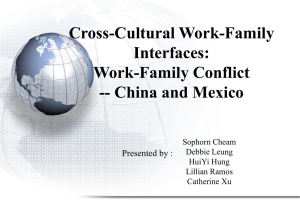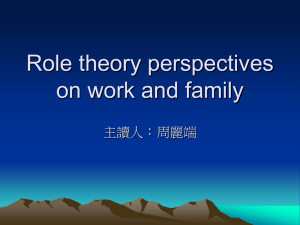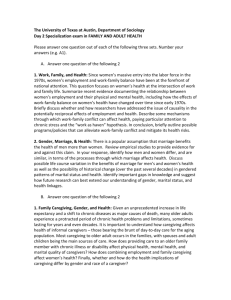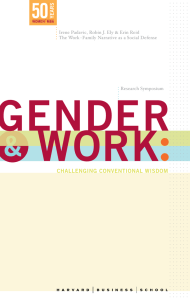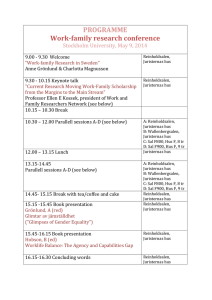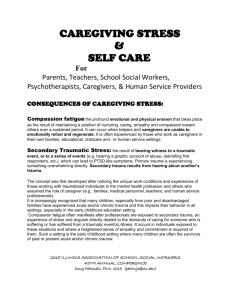Work Family Balance - Michigan State University
advertisement
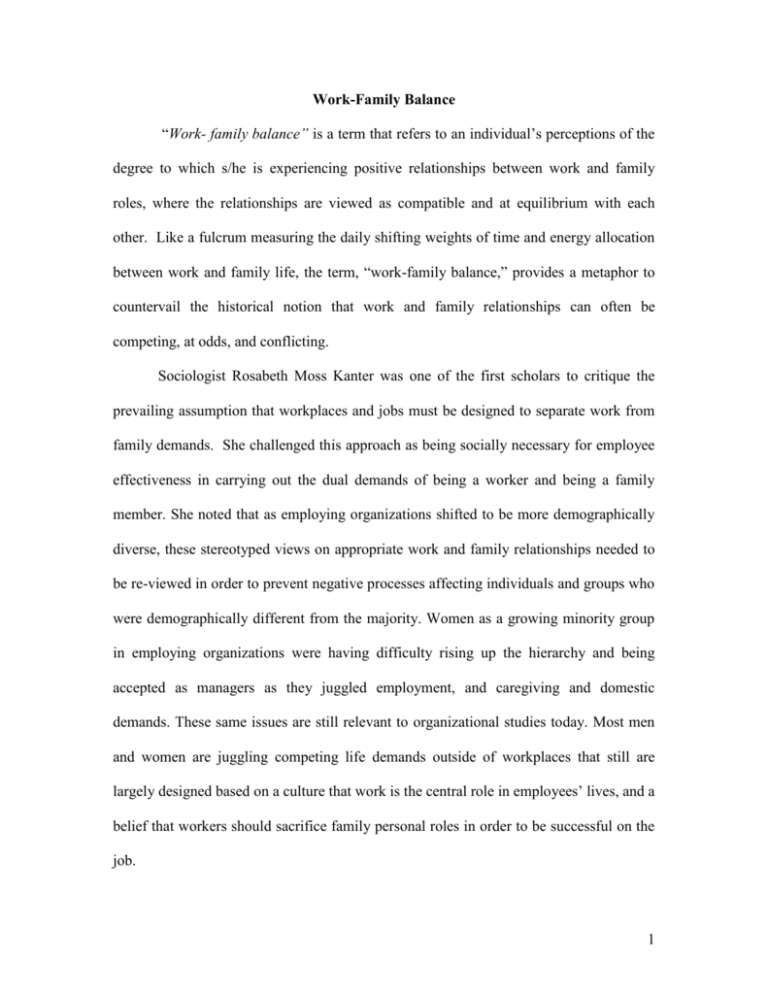
Work-Family Balance “Work- family balance” is a term that refers to an individual’s perceptions of the degree to which s/he is experiencing positive relationships between work and family roles, where the relationships are viewed as compatible and at equilibrium with each other. Like a fulcrum measuring the daily shifting weights of time and energy allocation between work and family life, the term, “work-family balance,” provides a metaphor to countervail the historical notion that work and family relationships can often be competing, at odds, and conflicting. Sociologist Rosabeth Moss Kanter was one of the first scholars to critique the prevailing assumption that workplaces and jobs must be designed to separate work from family demands. She challenged this approach as being socially necessary for employee effectiveness in carrying out the dual demands of being a worker and being a family member. She noted that as employing organizations shifted to be more demographically diverse, these stereotyped views on appropriate work and family relationships needed to be re-viewed in order to prevent negative processes affecting individuals and groups who were demographically different from the majority. Women as a growing minority group in employing organizations were having difficulty rising up the hierarchy and being accepted as managers as they juggled employment, and caregiving and domestic demands. These same issues are still relevant to organizational studies today. Most men and women are juggling competing life demands outside of workplaces that still are largely designed based on a culture that work is the central role in employees’ lives, and a belief that workers should sacrifice family personal roles in order to be successful on the job. 1 From Work-Family Conflict To Work-Family Enrichment: Competing Negative and Positive Views Traditionally, researchers have assumed a “win-lose” relationship between work and family and focused on work-family conflict, based on the belief that individuals have limited time and resources to allocate to their many life roles. Most research relevant to the notion of work-family balance has been conducted on work-family conflict, which can be viewed as the opposite of work-family balance. The construct ”work-family balance” is a more positive way of viewing workfamily relationships. It is consistent with the emergence of a new stream of research being promulgated by such writers as Greenhaus and Powell on work-family enrichment, the idea that work and family can also enrich and complement each other. Overall, research on work-family balance can be characterized as being organized along these competing positive and negative perspectives. Work-Family Conflict The negative perspective on balancing work-family relationships emanates out of role conflict theory, which Goode noted assumed that having multiple roles is distracting, depletes resources, and results in role strain and overload. With regard to work family roles, when employees try to carry these competing demands out while being embedded in traditional workplaces that are designed to support separation of work and family demands, they are likely to experience higher work-family role conflict. Greenhaus and Beutell wrote one of the earliest theoretical articles on workfamily conflict. They defined work-family conflict as a type of inter-role conflict where work and family roles are incompatible and seen as competing for an individual’s time, 2 energy, and behaviors on and off the job. Their work built on earlier role theory by Ebaugh and others who defined a role as involving behavioral expectations associated with a position in a social structure. Early research on work and family didn’t necessarily differentiate where the role conflict was occurring, such as whether it was due to an inflexible job (work to family conflict) or whether it was due to not having back up child care for when a child was sick (family to work conflict) Later Kossek and Ozeki conducted a meta-analysis reviewing decades of studies that show that life and job satisfaction for men and women is affected by the type and direction of these competing role dynamics. Given women’s traditional greater responsibility for caregiving, work to family conflict was found to affect life satisfaction to a greater degree for women than for men. Job satisfaction for men and women was equally affected by family to work conflict. Understanding the type, direction, and source of the conflict can help organizations and managers design appropriate workplace interventions to support work-family balance. For example, having to work overtime on a job and being forced to miss a child’s school event is an example of time-based work-to-family conflict. However, being absent from work because a babysitter did not show up is an example of time-based family- towork conflict. For the overtime example, an organization might allow for just in time worker scheduling to allow those workers with the most interest in overtime to volunteer. In the other example, managing overtime wouldn’t solve the babysitter not showing up. Helping the employee find back-up care for emergencies or letting them work from home once in a while in emergencies would. 3 An example of energy-based family-to-work conflict is when an employee is too tired to work well in the morning because he or she was up all night with an ill spouse. An example of energy- based work to family conflict is when someone is too tired to cook dinner or clean the house, because of working too intensely on the job. In order to promote work- family balance to promote better energy allocation between roles, in the first example, the firm needs to provide dependent care support or leave from work. In the second example, the firm might need to increase staffing levels so the workload is dispersed among more workers, or provide stress management techniques that allow workers to take breaks. An example of behavior-based family-to-work conflict is when one is so stressed from a family demand, that the individual is unable to concentrate at work or exhibits private emotions such as crying at work that would be more associated with the private sphere. An example of behavior- based work- to-family conflict is when someone comes home and yells at one’s spouse or kicks one’s pet because of anger related to work. In these cases, interventions to reduce the stress in the particular domain where it is occurring would result in better work-family balance. Work-family enrichment. The positive approach to studying work-family balance emanates from Seiber’s role accumulation theory which assumes that having multiple life roles can be psychologically enriching, as long as the roles are ones that the individual has high identity with, sees of good quality, and reap rewards and life privileges. Under a role accumulation perspective, a person can achieve balance by being able to regulate and have greater control over when where and how invest time and energy between work and family to ensure that they perceive they are accumulating positive outcomes from both 4 roles. The more roles one has that provide positive rewards, the better off an individual is, unless s/he has too much too do from the sum of these roles (causing role overload) or has too many competing role demands. The assumption is that work and family balance have instrumental and affective paths. The instrumental path focuses on how positive skills and behaviors and rewards from one domain (such as income, learning how to manage people or solve problems) can help one perform better in the other domain. The affective path focused on the degree to which mood and emotions from one domain can seep in and positively impact how one feels, acts and behaves in the other domain. So if someone has a good day at work, s/he comes home and are able to have extra energy and emotions to allocate to the family. Or if one has a wonderful family life, s/he is able to bring these positive emotions to work. A final set of studies focus on the processes of balancing relationships between work and family. Some writers focus on compensation- how having a better role quality and higher identity in one domain such as the work role may compensate for lower role quality and investment in another domain such as family. For example, an individual who highly identifies with work might invest more in work roles to compensate for a less fulfilling family life. Other writers might focus on segmentation and integration processes, the degree to which individuals have preferences for keeping work and personal roles segmented or integrated. Job and organizational design can interact with preferences for the enactment of life roles and management of the work and family boundary. A study by Kossek, Lautsch, & Eaton on teleworking found that individuals who teleworked and adopted an integrative boundary management style were likely to experience higher work to family 5 conflict but not family to work conflict than individuals who adopted a separation style. Their study showed that the more the workplace is brought into the home via job and organizational design, the more likely it increases work-to- family conflict, particularly for individuals who like to integrate work and family roles (say watching children while taking a work call). Cross-over effects is another new area of study: how the work-family balance of one family member such as a wife or husband may transfer over positive and negative relationships to the other spouse. For example, if a spouse has a good or bad day at work the balance of the partner may be affected. Direction Of Work- Family Interactions, Disciplinary Foci, and Levels of Analysis It is also important to note that research on work-family balance is grounded in distinct disciplines that are not well integrated, which influences the direction and content of studies focus. Besides generally designing research studies as measuring generally positive or negative outcomes from balancing work and family, writers in the field have tended to focus on either how work affects family OR how family affects work. This tendency to assume a particular direction of relationship has ramifications for the measures and outcomes studies. In several handbooks such as Work and Life Integration and The Work and Family Handbook, the editors noted that researchers who study how family demands are affected by work demands often use different measures and focus on different levels of analysis in assessing work-family relationships then management scholars who might study how work responsibilities are affected by being a parent or a spouse. 6 One large cluster of studies focuses on how family demands affect work. Historically, much of the writing in the management and organizational literature followed this approach. A general assumption is that the more family and other nonwork demands and interests an individual has, the more likely work is going to be negative impacted. For example, researchers in this stream might measure the number of children an employee has, his or her marital status. They would then link these personal demographics to the degree to which a person experiences positive work attitudes (e.g., commitment, job satisfaction) and work behaviors (e.g., turnover, performance). The level of analysis tended to be largely individual and focused on the employees’ personal, family and work characteristics. The other directional group of studies examines the different ways work impacts the family. Writers coming from this approach tend to emanate out of psychology and sociology and belief that the structure, stresses, and demands of work can make it more difficult for individuals to fulfill their family responsibilities as well as experiencing job stress at home. Some people refer to this negative seepage as negative spillover from work to home. Writers from this perspective might measure the degree to which inflexible work hours, lack of supervisor support, job demands and the structure of the workplace, negatively impact family and personal outcomes (e.g., job satisfaction, equal participation in family and domestic roles, life satisfaction, work-life balance). Here the level of analysis tended to focus more on workplace, job and organizational level. Researchers also might typically study of the availability of policies to support work and family, and the degree to which organizational culture and managers provided a supportive culture 7 and norms to facilitate use of policies as well as positive relationships between work and home. For example, an individual would not have to sacrifice their family life in order to get ahead at work. Moving From Study of Work and Family To Study of Work and Life Integration The future directions of the work and family field are moving from the notion of work and family balance and conflict to terms of growing acceptance of work and nonwork life balance or work and life balance. Such terms suggest that many employees, even those without dependents or visible forms of family related to caregiving can experience the need to seek work and family balance. It also suggests as men become more involved in caregiving and domestic roles and women more involved in work and breadwinning roles, conflict and enrichment may more strongly relate to the role an individual is enacting (e.g., caregiver or breadwinner) than gender. Future Research Trends Research on work-family balance is only likely to increase among organizational scholars. One reason for heightened interest around the globe in work-family balance today is changing workforce demographics. A general trend around the world is a gradual but constant growth in the labor market participation of women. Using the U.S. as an example, which has some of the highest rates, research by the Families and Work Institute shows that 83% of all two-parent families with children under 18 have both parents working at least part of this time. Another study by Cohen reports that half of all children under 18 will live in a single parent home for at least part of their childhood in the U.S. 8 Besides individuals with children, work-family balance concerns affect employees in general. For example, research by the Families and Work Institute reports that one third of employees say they have to choose between advancing in their jobs or devoting attention to their family or personal lives and one third will have managed elder care- care for a parent over the past year. Another reason for growing interest relates technological transformations that have resulted in some workplaces operating 24-7 as well as the ability to telework and be constantly accessible to work and jobs by email and cell phone and pagers even when not formally at the workplace. With 24-7 operations, the definition of the typical workday and what work hours are “normal” to support work family balance are also likely to redefined. For example, a U.S. based view of a 9-5 Eastern time zone of normal working hours, may not provide balance for workers where it is the middle of the night in India or China. Future research on work family balance will focus on differences in cross-cultural perceptions, how needs for balance shift over the life course, and how different jobs, family structures, and demographic groups may vary in their access to, perceptions of and outcomes from the level of work family balance they are afforded on and off the job. Multi-level research integrating individual and organizational perspectives and measures, and positive and negative measures is also likely to increase in future studies. Job design and work and family rewards and resources are likely to become of particularly increasingly importance in studying work family balance and conflict with highest stresses at either end of the economic spectrum. Individuals in higher paid managerial jobs are likely to experience higher work conflict and a lower balance due to 9 overwork. There will be too many work hours competing for individual time and energy and too high workloads. Individuals at the lower end of the economic spectrum will experience work and family conflict more likely due to a lack of flexibility and ability to control when one works and a lack of economic resources to buy high quality child care and dependent care. Thus, employees throughout the organization’s hierarchy will experience lower work-family balance but for different reasons. This trend makes it critical for future research to not only measure conflict, but to assess the processes and reasons for conflict and the role of organizational and job structures, as well as family and social and cultural structures (such as how family responsibilities are shared or viewed as ought to be shared) in enhancing or mitigating conflict and balance. The more that workers have access to jobs enabling higher control how when and where they do their jobs and the amount of workload, and the more that communities are design to provider greater public and private supports to enable dual enactment in work and family roles, the more likely that members of society will have greater work-life balance. Ellen Ernst Kossek See also gender division, sociology of paid work and employment, gendered organizations Further Readings and References Bond, J., Thompson, C., Galinsky, E., & Prottas, D. (2003). Highlights of the 2002 national study of the changing workforce. NY Families and Work Institute. Cohen, S. (2002). Cohabitation and the declining marriage premium for men. Work and Occupations, 29,343-383.. 10 Ebaugh, H. (1988). Becoming an ex: The process of role exit. Chicago: University of Chicago Press. Goode, W. (1960). A theory of role strain. American Sociological Review, 25, 483-496. Greenhaus, G. & Powell. G. 2006. When work and family are allies: A theory of workfamily enrichment. Academy of Management Review, 31, 72-92. Greenhaus, J. & Beutell, N. 1985. Sources of conflict between work and fmaly roles. Academy of Management Review, 10: 76-88. Hammer L.,Bauer T. Grandey A. (2003). Work-family conflict and work-related withdrawal behaviors. Journal of Business and Psychology.17, 419-436. Kanter, R. (1977). Work and family in the United States: A critical review for research and policy. NY, NY: Russell Sage. Kanter, R. M. (1977). Men and Women of the Corporation. New York: Basic Books. Kossek, E., Lautsch, B., Eaton, S. 2006. Telecommuting, control, and boundary management: Correlates of policy use and practice, job control, and work-family effectiveness. Journal of Vocational Behavior, 68, 347-367. Kossek, E. E. & Lambert, S. (2005). Work And Life Integration: Organizational, Cultural and Psychological Perspectives. Mahwah, N.J.: LEA Press. Kossek E. & Ozeki, C. (1998). Work-family conflict, policies and the job-life satisfaction relationship: A review and directions for work-family research. Journal of Applied Psychology.83: 139-149.fol Pitt-Catsouphes, M., Kossek, E. & Sweet, S. (2006). The Work-Family Handbook: Multi-Disciplinary Perspectives, Methods, and Approaches. Mahwah, N.J.: LEA Press. 11 Seiber, S. (1974). Toward a theory of role accumulation. American Sociological Review, 39, 567-578 12
